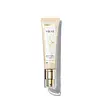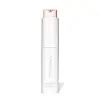What's inside
What's inside
 Key Ingredients
Key Ingredients

 Benefits
Benefits

 Concerns
Concerns

 Ingredients Side-by-side
Ingredients Side-by-side

Water
Skin ConditioningGlycerin
HumectantPropylene Glycol Dicaprylate/Dicaprate
Emollient1,2-Hexanediol
Skin ConditioningCaprylic/Capric Triglyceride
MaskingNiacinamide
SmoothingHydroxyethyl Acrylate/Sodium Acryloyldimethyl Taurate Copolymer
Emulsion StabilisingMica
Cosmetic ColorantSynthetic Fluorphlogopite
Propanediol
SolventRosa Damascena Flower Water
MaskingPolysorbate 60
EmulsifyingSorbitan Isostearate
EmulsifyingOrchid Extract
Skin ConditioningGlyceryl Acrylate/Acrylic Acid Copolymer
HumectantButylene Glycol
HumectantPhenoxyethanol
PreservativeSodium Phytate
Beta-Glucan
Skin ConditioningCitrus Limon Peel Oil
MaskingCitrus Aurantium Dulcis Flower Oil
AstringentCananga Odorata Flower Oil
MaskingCitrus Tangerina Peel Oil
MaskingThymus Vulgaris Oil
MaskingRosa Damascena Flower Oil
MaskingEthylhexylglycerin
Skin ConditioningSantalum Album Oil
MaskingPyrus Communis Fruit Extract
Skin ConditioningDehydroacetic Acid
PreservativeCI 77891
Cosmetic ColorantCI 77491
Cosmetic ColorantLimonene
PerfumingBenzyl Salicylate
PerfumingLinalool
PerfumingBenzyl Alcohol
PerfumingWater, Glycerin, Propylene Glycol Dicaprylate/Dicaprate, 1,2-Hexanediol, Caprylic/Capric Triglyceride, Niacinamide, Hydroxyethyl Acrylate/Sodium Acryloyldimethyl Taurate Copolymer, Mica, Synthetic Fluorphlogopite, Propanediol, Rosa Damascena Flower Water, Polysorbate 60, Sorbitan Isostearate, Orchid Extract, Glyceryl Acrylate/Acrylic Acid Copolymer, Butylene Glycol, Phenoxyethanol, Sodium Phytate, Beta-Glucan, Citrus Limon Peel Oil, Citrus Aurantium Dulcis Flower Oil, Cananga Odorata Flower Oil, Citrus Tangerina Peel Oil, Thymus Vulgaris Oil, Rosa Damascena Flower Oil, Ethylhexylglycerin, Santalum Album Oil, Pyrus Communis Fruit Extract, Dehydroacetic Acid, CI 77891, CI 77491, Limonene, Benzyl Salicylate, Linalool, Benzyl Alcohol
Water
Skin ConditioningPropanediol
SolventGlycerin
HumectantTricaprylin
MaskingDipropylene Glycol
Humectant1,2-Hexanediol
Skin ConditioningPolyglyceryl-3 Distearate
EmulsifyingPolyurethane-15
Betaine
HumectantSodium Acrylate/Sodium Acryloyldimethyl Taurate Copolymer
Emulsion StabilisingAcrylates/C10-30 Alkyl Acrylate Crosspolymer
Emulsion StabilisingGlyceryl Stearate
EmollientCetearyl Alcohol
EmollientTromethamine
BufferingPolyisobutene
Synthetic Fluorphlogopite
Hyaluronic Acid
HumectantEthylhexylglycerin
Skin ConditioningGlyceryl Stearate Citrate
EmollientMica
Cosmetic ColorantSorbitan Oleate
EmulsifyingCaprylyl/Capryl Glucoside
CleansingCitrus Aurantium Bergamia Fruit Oil
MaskingOlea Europaea Fruit Oil
MaskingSqualane
EmollientCitrus Aurantium Dulcis Peel Oil
MaskingTin Oxide
AbrasiveSolanum Melongena Fruit Extract
Skin ConditioningLavandula Angustifolia Oil
MaskingJuniperus Virginiana Oil
MaskingPelargonium Graveolens Flower Oil
MaskingDisodium Acetyl Glucosamine Phosphate
Skin ConditioningCopaifera Officinalis Resin
MaskingSodium Glucuronate
HumectantMagnesium Sulfate
Myrtus Communis Oil
MaskingArtemisia Vulgaris Oil
PerfumingRosa Damascena Flower Oil
MaskingFerula Galbaniflua Resin Oil
AntimicrobialLimonene
PerfumingLinalool
PerfumingCI 77891
Cosmetic ColorantCI 77491
Cosmetic ColorantWater, Propanediol, Glycerin, Tricaprylin, Dipropylene Glycol, 1,2-Hexanediol, Polyglyceryl-3 Distearate, Polyurethane-15, Betaine, Sodium Acrylate/Sodium Acryloyldimethyl Taurate Copolymer, Acrylates/C10-30 Alkyl Acrylate Crosspolymer, Glyceryl Stearate, Cetearyl Alcohol, Tromethamine, Polyisobutene, Synthetic Fluorphlogopite, Hyaluronic Acid, Ethylhexylglycerin, Glyceryl Stearate Citrate, Mica, Sorbitan Oleate, Caprylyl/Capryl Glucoside, Citrus Aurantium Bergamia Fruit Oil, Olea Europaea Fruit Oil, Squalane, Citrus Aurantium Dulcis Peel Oil, Tin Oxide, Solanum Melongena Fruit Extract, Lavandula Angustifolia Oil, Juniperus Virginiana Oil, Pelargonium Graveolens Flower Oil, Disodium Acetyl Glucosamine Phosphate, Copaifera Officinalis Resin, Sodium Glucuronate, Magnesium Sulfate, Myrtus Communis Oil, Artemisia Vulgaris Oil, Rosa Damascena Flower Oil, Ferula Galbaniflua Resin Oil, Limonene, Linalool, CI 77891, CI 77491
Ingredients Explained
These ingredients are found in both products.
Ingredients higher up in an ingredient list are typically present in a larger amount.
1,2-Hexanediol is a synthetic liquid and another multi-functional powerhouse.
It is a:
- Humectant, drawing moisture into the skin
- Emollient, helping to soften skin
- Solvent, dispersing and stabilizing formulas
- Preservative booster, enhancing the antimicrobial activity of other preservatives
Ci 77491 is also hydrated iron III oxide. It's sole purpose is to give a red/pink hue to products.
Iron III oxides are classified as inorganic chemicals for coloring.
Synthetically created Ci 77491 is considered safer than those naturally found. This is because the synthetically created version may contain less impurities. Iron oxides are generally non-toxic and non-allergenic.
Learn more about CI 77491Ci 77891 is a white pigment from Titanium dioxide. It is naturally found in minerals such as rutile and ilmenite.
It's main function is to add a white color to cosmetics. It can also be mixed with other colors to create different shades.
Ci 77891 is commonly found in sunscreens due to its ability to block UV rays.
Learn more about CI 77891Ethylhexylglycerin (we can't pronounce this either) is commonly used as a preservative and skin softener. It is derived from glyceryl.
You might see Ethylhexylglycerin often paired with other preservatives such as phenoxyethanol. Ethylhexylglycerin has been found to increase the effectiveness of these other preservatives.
Glycerin is already naturally found in your skin. It helps moisturize and protect your skin.
A study from 2016 found glycerin to be more effective as a humectant than AHAs and hyaluronic acid.
As a humectant, it helps the skin stay hydrated by pulling moisture to your skin. The low molecular weight of glycerin allows it to pull moisture into the deeper layers of your skin.
Hydrated skin improves your skin barrier; Your skin barrier helps protect against irritants and bacteria.
Glycerin has also been found to have antimicrobial and antiviral properties. Due to these properties, glycerin is often used in wound and burn treatments.
In cosmetics, glycerin is usually derived from plants such as soybean or palm. However, it can also be sourced from animals, such as tallow or animal fat.
This ingredient is organic, colorless, odorless, and non-toxic.
Glycerin is the name for this ingredient in American English. British English uses Glycerol/Glycerine.
Learn more about GlycerinLimonene is a fragrance that adds scent and taste to a formulation.
It's found in the peel oil of citrus fruits and other plants such as lavender and eucalyptus. The scent of limonene is generally described as "sweet citrus".
Limonene acts as an antioxidant, meaning it helps neutralize free radicals.
When exposed to air, oxidized limonene may sensitize the skin. Because of this, limonene is often avoided by people with sensitive skin.
The term 'fragrance' is not regulated in many countries. In many cases, it is up to the brand to define this term. For instance, many brands choose to label themselves as "fragrance-free" because they are not using synthetic fragrances. However, their products may still contain ingredients such as essential oils that are considered a fragrance.
Learn more about LimoneneLinalool is a fragrance and helps add scent to products. It's derived from common plants such as cinnamon, mint, citrus, and lavender.
Like Limonene, this ingredient oxidizes when exposed to air. Oxidized linalool can cause allergies and skin sensitivity.
This ingredient has a scent that is floral, spicy tropical, and citrus-like.
Learn more about LinaloolMica is a naturally occurring mineral used to add shimmer and color in cosmetics. It can also help improve the texture of a product or give it an opaque, white/silver color.
Serecite is the name for very fine but ragged grains of mica.
This ingredient is often coated with metal oxides like titanium dioxide. Trace amounts of heavy metals may be found in mica, but these metals are not harmful in our personal products.
Mica has been used since prehistoric times throughout the world. Ancient Egyptian, Indian, Greek, Roman, Aztec, and Chinese civilizations have used mica.
Learn more about MicaPropanediol is an all-star ingredient. It softens, hydrates, and smooths the skin.
It’s often used to:
Propanediol is not likely to cause sensitivity and considered safe to use. It is derived from corn or petroleum with a clear color and no scent.
Learn more about PropanediolRosa Damascena Flower Oil is an essential oil made from the Damask Rose. It is often used as a fragrance in cosmetics.
Rose Oil has antibacterial and antioxidant properties due to its terpene, glycoside, flavonoid, anthocyanin, and Vitamin C content.
Other major parts of Rose Oil include citronellol and geraniol. Both of these are known EU allergens and cause contact-allergies.
The downsides of this ingredient outweight the positives.
Learn more about Rosa Damascena Flower OilSynthetic Fluorphlogopite is the synthethic version of mica. It consists of fluorine, aluminum and silicate.
Synthetic Fluorphlogopite is used to add volume to products.
It is considered non-irritating on the skin.
Learn more about Synthetic FluorphlogopiteWater. It's the most common cosmetic ingredient of all. You'll usually see it at the top of ingredient lists, meaning that it makes up the largest part of the product.
So why is it so popular? Water most often acts as a solvent - this means that it helps dissolve other ingredients into the formulation.
You'll also recognize water as that liquid we all need to stay alive. If you see this, drink a glass of water. Stay hydrated!
Learn more about Water